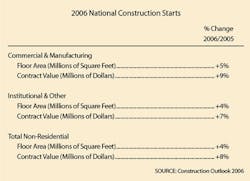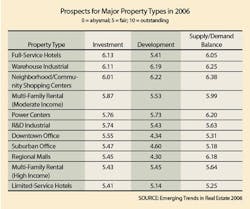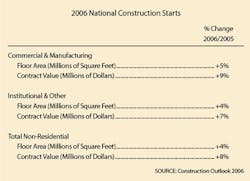Industry Forecast 2006
Two reports offer practical insight into commercial building market conditions and drivers, as well as investment and development prospects. This information was excerpted and compiled from New York City-based McGraw-Hill Construction’s Construction Outlook 2006 report, as well as from Emerging Trends in Real Estate® 2006, a report published by the Washington, D.C.-based Urban Land Institute and PricewaterhouseCoopers LLP.
According to Construction Outlook 2006: Over the past 2 years, the construction industry has dealt with a sharp increase in building-material costs - a situation that isn’t helped by the upward pressure on prices following the 2005 hurricanes. It’s now estimated that total construction in 2005 will have advanced 8 percent to $637 billion. And although 2006 features steeper price levels and interest rates, it will also include positives for the industry. The sum of various sectors produces a 3-percent gain for total construction. The 2006 environment will lead to some variation in the performance by major construction sector; new construction starts for 2006 are estimated to be $654 billion, a 3-percent gain over 2005.
Other key points from Construction Outlook 2006:
- Income properties (retail, office, hospitality, multi-family housing) will advance 7 percent in dollar volume and 3 percent in square footage. Hotel construction is anticipated to experience double-digit growth, while more moderate gains are expected for offices and warehouses. Multi-family housing is expected to be essentially stable on a square-footage and dwelling-unit basis. While retail construction will see a slight increase in dollar volume, square footage will be down from 2005.
- Institutional building will rise 7 percent in dollar volume and 4 percent in square footage. The slow rise in the fiscal health of several states, combined with money from bond measures passed in recent years, will help school-construction growth. More expansion is expected for healthcare facilities, after the substantial gain in 2005.
- Manufacturing building is forecasted to rise 9 percent, as firms increase capital spending. Some growth may come from refinery projects, given the call to increase the nation’s refining capacity in the aftermath of the 2005 hurricanes.
According to Emerging Trends in Real Estate 2006: After an “extremely” prolonged decade-plus cyclical upturn, with the last few years juiced by a healthy dose of record-low interest rates, the U.S. commercial and multi-family real estate markets appear to have reached a pricing peak, and investment returns will ratchet down during 2006 in a slow but steady reversion toward the mean.
Other key points from Emerging Trends in Real Estate 2006:
- In 2006, real estate markets will reach a pricing peak, cap rate compression ends, and performance ratchets down as value gains level off. The year promises to usher in a period of tolerable but relatively lackluster returns for property investment portfolios. Sellers do better than buyers.
- Modest property cash flow improvements from rising occupancies in most property sectors will help offset any increases in cap rates, with interest rates expected to advance. Full-service hotels rank as the favored property type. Technology and corporate productivity initiatives continue to dampen office-demand growth.
- Pricing above replacement cost for existing real estate may encourage a round of unnecessary development and threaten steady progress toward supply/demand balance in many markets by 2007 or 2008. Rising construction expenses, however, could diminish developer enthusiasm and lengthen the ongoing recovery.
Forecast Information By Sector ...
Retail
Construction Outlook 2006: Declines in housing and the tight concentration of construction activity among a small number of the largest U.S. retail companies remains a concern; consequently, retail starts are expected to decline 5 percent in 2006 to a still-healthy 283 million square feet. According to the Urban Land Institute, traditional enclosed shopping malls are losing favor. Recent department-store mergers are likely to quicken the pace of change for regional malls. Developers have built only a few new regional malls over the past several years, and are instead building open-air lifestyle centers. These centers are much smaller than regional malls and are more like old-style village centers - designed to bring in consumers and keep them there.
Emerging Trends in Real Estate 2006: Retail property performance “cannot get any better.” The market for properties will begin to diverge as buyers become more discerning, distancing themselves from centers with questionable tenant rosters.
Office
Construction Outlook 2006: Office construction is forecasted to rise 9 percent to 167 million square feet. With office-employment gains holding at historically healthy levels, corporations will find that they must expand their office space to make room for growing ranks. Still, the recovery will be more modest than in prior years, and office construction starts will not approach the last pinnacle of 300 million square feet (set in 2000).
Emerging Trends in Real Estate 2006: Recovery gains momentum ... finally! Vacancies will continue to decline, and rental increases will extend beyond New York City; Washington, D.C.; and southern California markets. The office market looks chancy compared to other traditional core investment categories (apartments, industrial, and retail). “Investors should have higher yield expectations” unless they are buying trophy office properties in barrier-to-entry 24-hour markets with good jobs and growth prospects.
Hospitality
Construction Outlook 2006: The year looks hopeful for hotel construction, with construction starts expected to rise 16 percent to 58 million square feet. Projects slated to begin are substantial in size, with a major emphasis on “condo hotels” (blended residential/hotel developments).
Emerging Trends in Real Estate 2006: Hotels make a “roaring comeback,” boosting all segments. New construction will begin to add supply by year-end 2006 and into 2007. Hotels have legs as long as the economy expands. “It will be another 2 years before a new round of development kicks up room supplies” and slows revenue growth. Hotels are the most sensitive and unpredictable property segment.
Multi-Family Housing
Construction Outlook 2006: The underpinnings of a robust multi-family market will continue during 2006, when multi-family housing is expected to rise an additional 1 percent to 475,000 units. While rents have been generally flat, the sharp rise in housing prices in certain markets provides room for rents to move up. In those markets facing an overabundance of condos, a shift back to apartments can be anticipated. Downtown redevelopment efforts will persist in encouraging multi-family endeavors.
Emerging Trends in Real Estate 2006: Multi-family housing will be the leader for other sectors. If development imbalances can be controlled, a greater number of renters should strengthen occupancies and supplement cash flows, creating a full-blown landlord’s market. These improved supply/demand fundamentals will shore up values as interest rates rise.
Educational
Construction Outlook 2006: Based on projected enrollments, school-construction needs remain strong, and funding has been made available. With improving state fiscal conditions, it’s expected that more of this money will lead to construction starts, elevating the level of contracting over the next 2 to 3 years. Due to a gain in endowments, it’s expected that colleges and universities will bring deferred construction projects closer to the groundbreaking stage. For the educational building category as a whole, it’s estimated that contracting in 2006 will rise 6 percent to 225 million square feet. From 1996 to 2004, renovation work climbed from $4.1 billion to $8.6 billion, a substantial 122-percent gain. Over the next 2 years, it’s estimated that renovation work will be up another 9 percent to $9.5 billion.
Healthcare
Construction Outlook 2006: Always in the background is the growing demand for healthcare services, which are expected to rise significantly as Baby Boomers move toward retirement. For 2006, it’s estimated that construction of healthcare facilities will advance an additional 2 percent to 107 million square feet.


